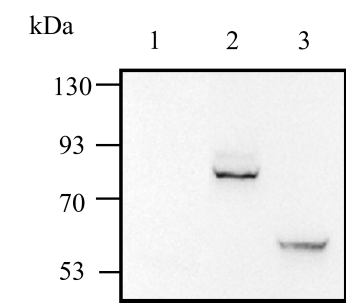Cat.No:GM-77429AB
Product:Anti-Myc mIgG2a Antibody
Cat.No:GM-77429AB
Product:Anti-Myc mIgG2a Antibody
GM-77429AB-10
GM-77429AB-100
GM-77429AB-1000
Source/Isotype Monoclonal Mouse IgG2a
Species Reactivity Tag
Conjugate Unconnjugated
Other Names /
Application Western blotting: 1:500-1:2000; FC-Quality tested
Background A myc tag is a polypeptide protein tag derived from the c-myc gene product that can be added to a protein using recombinant DNA technology. It can be used for affinity chromatography, then used to separate recombinant, overexpressed protein from wild type protein expressed by the host organism. It can also be used in the isolation of protein complexes with multiple subunits. A myc tag can be used in many different assays that require recognition by an antibody. If there is no antibody against the studied protein, adding a myc-tag allows one to follow the protein with an antibody against the Myc epitope. Examples are cellulite localization studies by immunofluorescence or detection by Western blotting. The peptide sequence of the myc-tag is (in 1- and 3-letter codes, respectively): EQKLISEEDL and Glu-Gln-Lys-Leu-Ile-Ser-Glu-Glu-Asp-Leu. It can be fused to the C-terminus and the N-terminus of a protein.
Formulation 20mM Histine, 50% glycerinum, 0.05% Bacteriostatic preservative, pH 6.0.

Cat.No:GM-77429AB
Product:Anti-Myc mIgG2a Antibody
GM-77429AB-10
GM-77429AB-100
GM-77429AB-1000
Source/Isotype Monoclonal Mouse IgG2a
Species Reactivity Tag
Conjugate Unconnjugated
Other Names /
Application Western blotting: 1:500-1:2000; FC-Quality tested
Background A myc tag is a polypeptide protein tag derived from the c-myc gene product that can be added to a protein using recombinant DNA technology. It can be used for affinity chromatography, then used to separate recombinant, overexpressed protein from wild type protein expressed by the host organism. It can also be used in the isolation of protein complexes with multiple subunits. A myc tag can be used in many different assays that require recognition by an antibody. If there is no antibody against the studied protein, adding a myc-tag allows one to follow the protein with an antibody against the Myc epitope. Examples are cellulite localization studies by immunofluorescence or detection by Western blotting. The peptide sequence of the myc-tag is (in 1- and 3-letter codes, respectively): EQKLISEEDL and Glu-Gln-Lys-Leu-Ile-Ser-Glu-Glu-Asp-Leu. It can be fused to the C-terminus and the N-terminus of a protein.
Formulation 20mM Histine, 50% glycerinum, 0.05% Bacteriostatic preservative, pH 6.0.
